Being immersed in the fitness industry provides me with a ton of different opportunities to experience different techniques, methodologies, and products. I recently had the privilege of a...
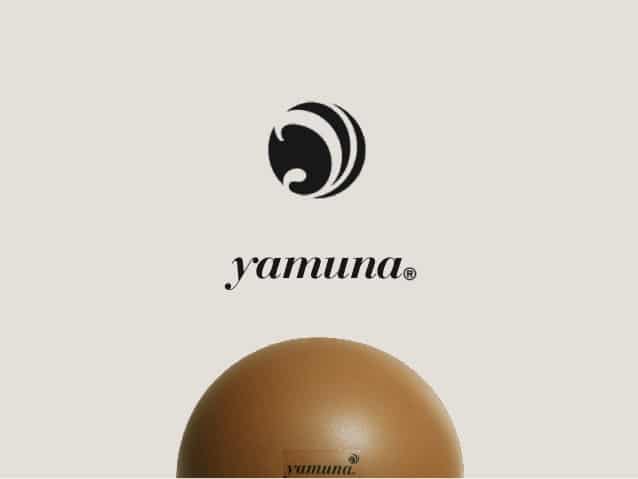

Being immersed in the fitness industry provides me with a ton of different opportunities to experience different techniques, methodologies, and products. I recently had the privilege of a...
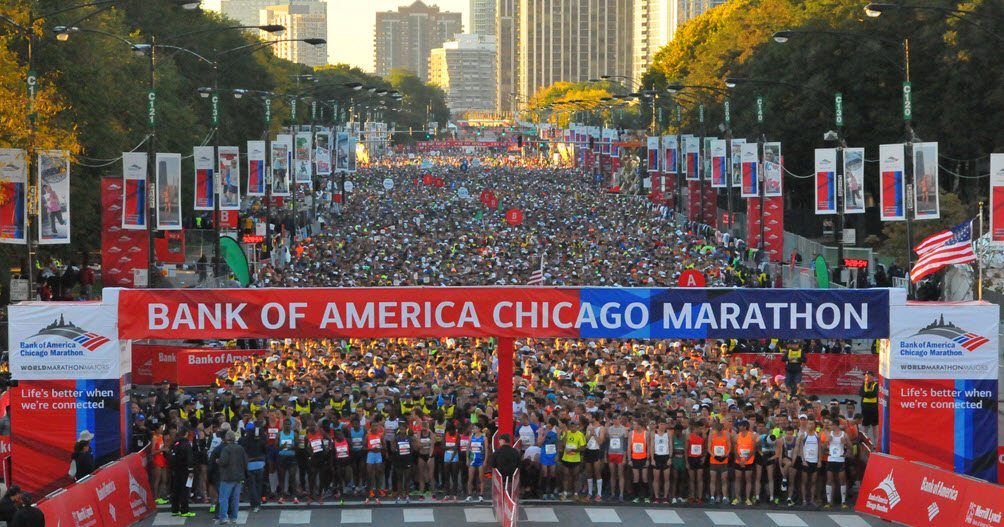
Leading up to the Chicago Marathon 2016 The Chicago Marathon provides an excellent course, plenty of support and, for me, a chance to visit home for a few days. It was no different for me this...
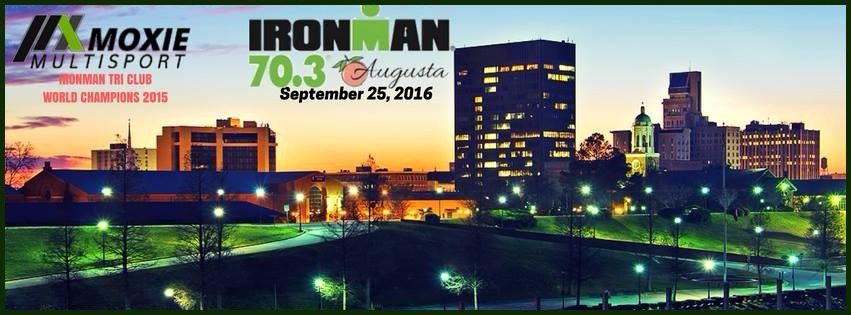
September 25 was going to be my day. The Ironman Augusta 70.3 triathlon was finally here. The race I had been training so hard for on one of my favorite courses. It was four-and-a-half months...
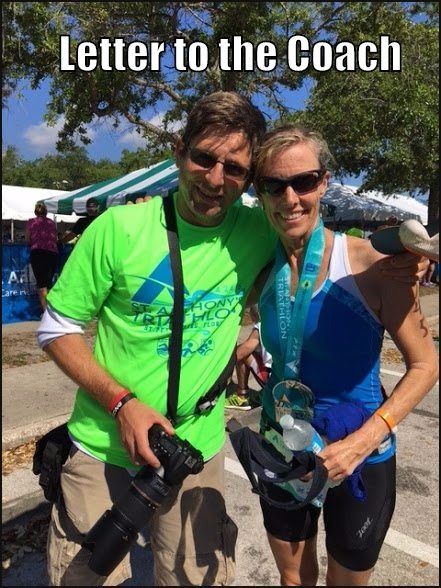
I have been an endurance coach for some time now. Once in a while, I receive an email from a client which chokes me up with pride. Today, I received one of those letters, so instead of sharing it...
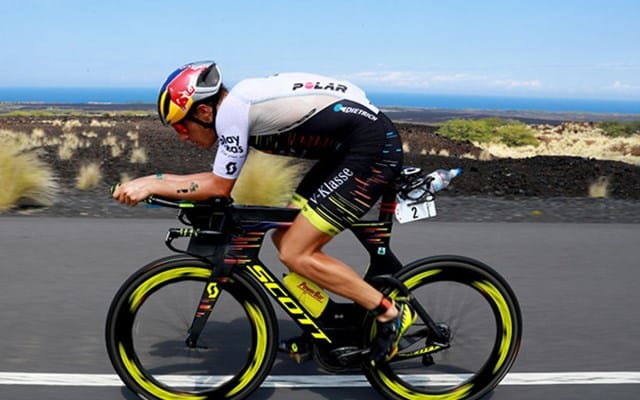
I found when looking for ways to get faster on the bike, is that there is so much information, from different coaches and experts, that it can be confusing and overwhelming. Personally, I...
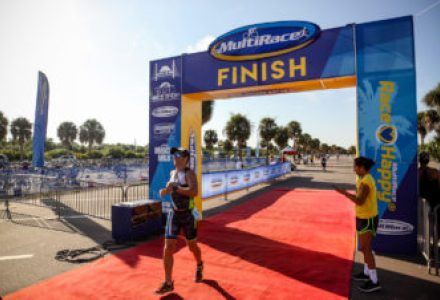
The previous post was a review of the FD3 Triathlon Series as if it was a product. Below you will find a more detailed account of my personal experiences during the race. Let me know in the...
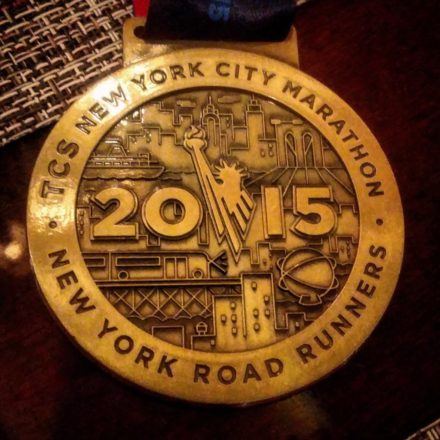
If you didn’t have an opportunity to read the epic writing in the previous post, I discussed the reason “why” I ran the NYC Marathon, then I highly recommend that you do. Not just because the writing was fantastic, but it is my hope that the recap will be more emotionally moving.
Delta carried us to New York City and back with no issues. I was upgraded to the business class on my departing flight, and returned to Tampa in economy class. Even with my average size, I felt extremely cramped in economy. Scott and his six-foot-one-inch frame looked extremely uncomfortable. It is obvious, that Delta increased their upgraded business class at the expense of the comfort of the economy class passengers. My suggestion to anyone flying Delta to the NYC Marathon, just include the cost of the upgrade if the flight it over 3 hours.
The plans were made well in advance for room and board. After each of us declared our opinions for a hotel of choice, one of our teammates found a condo in Chelsea that would accommodate all of us comfortably and provide a full kitchen to save a little money on meals.
Per an email from VRBO (Vacation Rentals By Owner) we were to pick up the keys at a local pizza restaurant located next door to the building housing the condo.
Team Tampa PKD arrived around 4 pm and the employees working that afternoon had absolutely no idea what we were talking about. Of course, we called the management company and were basically told they did not receive the contract. When we had the contract in hand we called the agency back but no one would answer our calls.
Here we were, in New York City, on marathon weekend, not to mention the third and fourth game of the World Series, homeless.
Teammate Kevin O’Brien to the rescue. Kevin works for a landscape development company and happens to travel quite a bit, which was lucky for us. With his Hilton Honors status we were able to procure two rooms at the Hilton Garden Inn located in Tribeca. Thank you Kevin.
The rooms were updated, immaculate and comfortable. Another, nice little value add of the Hilton Honors was the choice of extra points or free breakfast. Kevin being the generous person he is, opted for the free breakfast for us which again helped save a little bit of money. Again, Thank you Kevin.
With all of us now settled, we headed to the Javits Center to pick up our NYC Marathon packets. The bibs numbered up to 72,999. It still amazes me how easy it is to retrieve a bib, swag and t-shirt at the expo. It runs like a well oiled machine.
There is a booth for every few thousand bib numbers. The athlete walks up to the booth that includes their bib number, shows ID and their registration card. Then they receive their NYC Marathon bib and other instructions, verify their info and then walk towards the t-shirt area where on the way, they pick up a plastic swag bag that also serves as the gear bag for the race. The official NYC Marathon t-shirt area is well-marked with a line for the different sizes and within a few minutes of walking into the expo, the athlete has bib, swag and t-shirt.
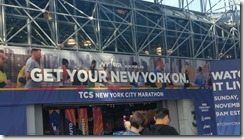
That isn’t the most exciting part of the NYC Marathon expo. There are vendors from all over the country whom give runners have the opportunity to try and buy the latest gear and gadgets.
One aspect of the expo I really enjoy, is the aura and feeling of the environment. There is an excitement in the air of the larger expos that increases my heart rate a little and excites me to race. It is probably one of my most favorite parts of any race weekend.
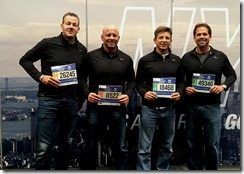
The following day we made another visit to the expo simply to walk around and make some purchases. I found a couple of vendors that I had met at other races and made some new contacts for product reviews. Stay tuned.
I have loved New York City since the first moment I stepped into Manhattan years ago. I have a lot of friends here, and I just really enjoy the pace and excitement of the city.

There is always one place, that is mandatory to visit, at least once, every time I am in town. John’s Pizza. I couldn’t believe my ears, when Rich and Kevin decided not to partake. It was their loss, so Scott and I headed over to John’s for lunch. Carb loading, baby, I just love it.
I could write a full post on John’s, so I wont go into the heavenly scrumptiousness of their pizza here, but trust this self-proclaimed, pizza connoisseur, when I say the explosion of flavors that emanate from each bite, redefines the word delicious.
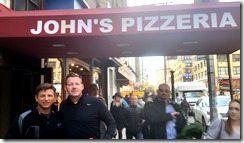


Saturday night, we were scheduled to have dinner with the PKD Foundation and the other runners from different areas at Carmine’s. Scott, Kevin, Karen and I were all pretty familiar with the city and had even known of Carmine’s as it is pretty well-known.
That night we entered the subway and got off at 42nd street in order to head over to 44th where Carmine’s was located, as we started up the stairs from the station, Scott mentions the address which made Kevin and I do a double take. 2400 W Broadway, which was Broadway and 90th street. At the moment we were on 44th st which means we were 46 blocks away. That was a few miles from where we were at that point.
Of course like men we decided that maybe the address was wrong and went up anyway. As it turns out, it was correct. There was a newer Carmine’s uptown and we were in the wrong place and already fashionably late.
It ended up working out for us again. We caught the subway up to 86th and when we arrived, food was just being served. How long could this luck hold, right?
The dinner was fantastic and we met a bunch of really amazing people who were just as passionate about running for PKD as we were.


Like good little runners we went back to the hotel and retired for the night in anticipation for the NYC Marathon the next morning.
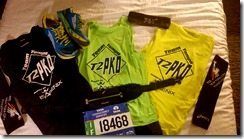
As I mentioned both in the last post and in my NYC Marathon recap from last year; the logistics for this race are not the most convenient. It involves a ferry to Staten Island then a bus to security, a decent walk to the assigned village and finally another walk to the specific corral.
An announcement came out from the NYC Marathon staff, about two months prior to sign up for transportation to the start and of course we all missed and ended up getting assigned the 5:45am ferry to Staten Island. Since three of us had already experienced the ferry and knew that there was no accountability, we decided to just take the 7am ferry instead, not only giving us a little more time in the morning, but also keeping us out of the chilly temps for a couple of hours.
The lesson I learned here was there are two choices, either go by the scheduled time and arrive with a lot of time to spare, sit around have some coffee and bagels while waiting for the start, or go a little later and hope to make it to the corral at the time of your scheduled start.
We took the latter ferry and ended up having to wait for two ferries to get over to the island and then when finally getting on the bus, the traffic was so heavy we ended up having to rush to the corrals in order to make the 9:40 start. It was probably perfect for the rest of the team that had later starts, but for Rich and I it was a little tight. Personally, I do prefer the latter.

I found my green village, dropped off my gear bag with my long sleeve shirt and pants, and headed to the corral just prior to the 9am cut-off to enter the corral. Now I had about half-an-hour to stretch and use the portlet one last time.
I was talking to a woman from Basel, England when I heard my name being called. Ryan Wallace, was a Facebook friend and runner I met at last year’s race. A really fun guy to hang with, so after chatting for a bit we found we were looking at accomplishing the goal of 3:50 or better. Score! Someone to run with.
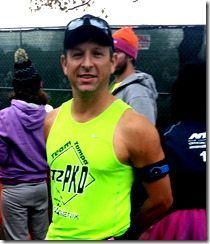
In the Start Corral
They opened up the corral to head closer to the start line around 9:30am, and just after the final note to one of the most beautiful renditions of our national anthem I have ever heard, sung by opera singer (and runner) Susanna Phillips Huntington, and announcements by the executive director, the gun went off and we were running.
The NYC Marathon is the largest marathon in the world. Largest meaning the most athletes run the course of any marathon in the world.. This year there were over 50,000 finishers. It boasts spectacular views, fantastic support from the spectators, and a challenging course. The route takes the runners through all five major boroughs of the city, starting in Staten Island, crossing the Verrazano Bridge to Brooklyn, heading north into Queens crossing the 59th St bridge, then into Manhattan crossing the Queensboro Bridge, north into the Bronx over the Willis Ave Bridge, turning south back into Manhattan over the Madison Avenue bridge and then finally the incline to the finish line in the heart of Central Park.
The experience this year was better than last, as the temperatures were much better as we started around 55 degrees Fahrenheit and just a little breeze versus the 30 degree temps and 33 mph winds from 2014.
Ryan, his friend, and I started the NYC Marathon conservative for the first couple of miles, but as we rounded the first 5k I noticed we started to increase our pace. I only was witness to it due to calculating my 5k under 27 minutes, which being under a 9 minute mile that soon, concerned me a little, but I was feeling really strong.
The spectators in the NYC Marathon are everywhere and they clap, yell and scream not only for their family and friends, but for any one they seem to be inspired by. Statistics pretty much show, that even know there were over 50,000 athletes running this race, and hundreds of thousands of finishers in marathons all over the world, less than 1% of the population has finished a marathon. In other words there were a lot of people to be inspired by during this race and the spectators expressed that.
Ryan and I ran together up to about mile nine, constantly telling each other to slow down, yet neither of us could hold a slower pace for very long. About that point, a pressure emanating from my bladder was increasing to a point where I was just not comfortable any longer, so I speeded up to the mile 10 aid station to relieve myself. My thinking was speed up, use the facilitates and then speed back up just enough to catch Ryan again.
Unfortunately, we didn’t cross paths again during the race. I was out there on my own, all by myself. It was just me and 50,000 of my closest friends.
There was plenty to see as I continued on my NYC Marathon journey. Achilles International volunteers were out in droves this year with guides helping blind and other challenged runners through the race. Guides would run in a formation with one tethered to the blind runner and then three-to-four others running on each side of them constantly helping to clear a path through the crowd. It was so motivating, that I knew somewhere down the line in my own journey I would have to help like that in some way in the future.
As I crossed the 13.1 mile marker of this NYC Marathon, and saw the clock I realized that I had been running for an hour and fifty minutes. That for me was fast, but I was still feeling really strong. The sights of the area’s architecture, parks, people and the smells of the local restaurants were consistently keeping my mind occupied as I just let my legs decide what they were going to do.
I was concerned though. I know enough about myself, that keeping this pace would have it’s consequences toward the final miles.
My favorite bridge on NYC Marathon course is the Queensboro bridge. It feels like it never ends, but the view of Manhattan and the Hudson is spectacular. Not to mention, the completion of the bridge is a u-turn with a horde of spectators that it feels like a roar of excitement is exuded from them. I felt a boost of energy when I crossed mile 16.
I was actually a little impressed with myself as I hadn’t really slowed as of yet. It is usually around this mile marker that begins the stiffness of the previous miles.
The next checkpoint for me is usually mile 18, but that too came and went without any real pain. My inner dialogue started having delusions of grandeur of possibly finishing the race around the 3:40 mark which be a huge PR for me.
As I crossed the Willis avenue bridge, I felt the start of a twinge in my left leg and a smile crept across my face and out loud I said to myself,”There it is.”
The NYC Marathon mile 20 clock showed I was two hours and fifty-two minutes into the race, which was already better than last year. My thinking at that point was that I could pretty much slow to a ten minute mile at this point and still cross under four hours, but that didn’t happen.
Mile 21 came at just three hours which was a first in a while for me. I am usually only at 20 by three hours and here I was a full mile closer to the finish. My period of optimism was cut short by a stiffness in my right leg that quickly became painful.
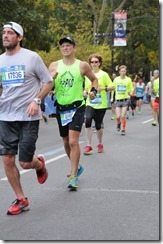
I walked though the next NYC Marathon aid station and grabbed a banana from the hand of a volunteer thinking just get some more glycogen to my legs so I finish this last five miles.
What little stride I had became periods of walking between miles 22 and 23 as the pain started to sear and engulf the rest of my leg. It was getting harder and harder to bend my right knee as the stiffness was setting in.
Central Park came and the crowds were getting louder and more dense. I did not want to walk through the park with all these people. I wanted to run in strong, but the pain was getting more and more intense. I actually yelled at myself, “C’mon legs. WTF are you doing!!!”
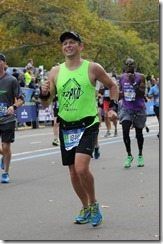
My mind drifted to Erika at that moment. As I was trying to run stiff-legged and just suffer through this intense pain, I thought that this frustration and uncomfortable feeling must be what Erika feels all the time. The disappointment at feeling run down, the pain that comes with these huge cysts on her Kidneys and the eternal uncomfortable feeling that keeps her from sleep and just enjoying life, must be one hundred times worse that what I was feeling.
If Erika had to continually go through this pain, then I could at least endure it until I reach the finish line.
I didn’t stop running, no matter how much it hurt. I thought about Erika and the last couple of years of misery she must have been going through, and how Jennifer would also have to also have a painful times ahead through her recovery from donating a kidney. It kept me going as I really felt like I was going through it for them.
I am not a totally idiot, I know that running the NYC Marathon of which I enjoy doing, really would do nothing for either of them. It was the fundraising and support where we as a team were doing the most good. Maybe it was for me. Maybe because I was not able to donate my kidney, that I the pain I was feeling now was so that I could empathize with both of them.
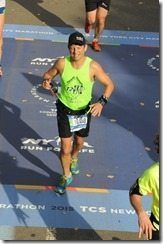
The NYC Marathon finish line was just as glorious as the other marathons I have completed. I was extremely happy to cross in 3:56 and at least beat my time from last year by about 10 minutes.
My official NYC Marathon finisher was medal handed to me, I was congratulated by a volunteer and ushered through to take continue the long mile walk to retrieve my gear bag. I was engulfed on all four sides with athletes as we all did the marathon shuffle through the park. There was a sense of peace and a little giddiness that filled the air.
We all did something extraordinary today. Whatever the reason “why”, we were bound at that moment by the accomplishment and conclusion of a journey that started with the decision to embark, the hours of training and the final step across the NYC Marathon Finish LIne.
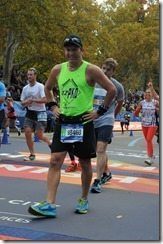
Once dressed in dry clothes, I found Rich and we headed out to The Keg Room which was where Team Tampa PKD would gather back together. As Rich and I were in the first wave, where he PR’d at an incredible time of 3:27, we arrived first. Kevin, whom was actually in the last wave to take off, showed up next followed closely by Karen and finally Scott. Everyone finished and accomplished what they set out to do, but I was most proud of Scott.

Scott had micro tears in his gastrocnemius muscle (Calf) and had been trying to rehab it for the last couple of weeks. I really didn’t think he would finish the NYC Marathon and we all told him it would have been ok if he didn’t . He did though and under 5 hours with walking. He also said that he felt like he didn’t feel like he did anymore damage.
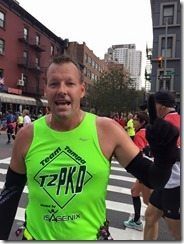
Scott Bragan
I am proud of the whole team. Team Tampa PKD was able to raise over 20,000 for PKD, finish the NYC Marathon and, most importantly, find a kidney donor for Erika.

Team Tampa PKD – (L to R) Scott Bragan, Rich O’Dea, Karen Dempsey, Brad Minus, & Kevin O’Brien
What kind of challenge are you partaking in or plan to journey towards?
Carpe Vitam!
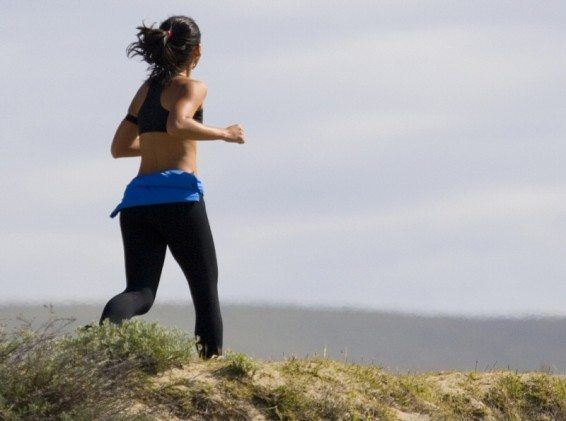
I can hear it now….”Know wonder they call you a Goof…you are crazy.”, “So, if I run slower I will get faster? You are out of your mind.” It was not to long ago I used to think the same thing, but as with everything I post, there are reasons and science to back it up.
Let’s face it, logic would dictate that pushing the pace of your easy days, as close to race pace as possible, would help you get fit faster and help you speed up, right? A lot of coaches, including myself, will tell you to run slow on your easy days, and easy days should be making up anywhere from 50-75% of your weekly mileage.
I have clients continuously asking me, “why are my easy days so slow?” The latest is my famous sit downs with my runners telling them to slow down after examining their data and finding them running tempo speeds during an easy day.
The answer to the question is what Arthur Lydiard and most other coaches would call the aerobic system. The aerobic system, or aerobic development, is the one of the most important fundamentals into unlocking your true potential.
Let us first check the stats on the energy contribution the aerobic system provides for races. As you can in the chart below, even the shorter events like the mile, over 80% of the energy required to run the race is produced via the aerobic system.
Aerobic training is the scientific fact that to move your body at higher intensities, the body needs to break down sugar and convert it to glycogen so it can be used as energy.
The aerobic system plus oxygen starts a chemical reaction known as Aerobic Glycolysis which continuously powers continuous endurance activities. In the aerobic system energy ATP is produced through Pyruvic Acid and Lipid/Protein fragments entering the Kreb Cycle and the Electron Transport Cycle.
Uh…what?
During aerobic respiration (yeah, that’s breathing) the body uses all the oxygen it needs to power the muscles. When you are running in your “aerobic zones” (easy runs), your muscles have enough oxygen to produce all the energy they need to perform.
See? Improving your capacity to transport and efficiently use all the available oxygen to produce energy will enable you to race faster since this makes up 85-99% of the energy needed to race.
Since running easy is aerobic development, what better way is there to train the aerobic system? There is none.
Capillary development – capillaries are the smallest of the body’s blood vessels and they help deliver oxygen and nutrients to the muscle tissues while exporting waste products out. The larger the number of capillaries you have surrounding each muscle fiber, the faster you can transport oxygen and carbohydrates to your muscles.
Aerobic training (easy running) increases the number of capillaries per muscle fiber, thus improving how efficiently you can deliver oxygen and fuel to your working muscles and how quickly they can clear waste products.
Myoglobin is a protein in the muscles that binds the oxygen that enters the muscle fiber. When oxygen becomes limited during intense exercise, myoglobin releases oxygen to the mitochondria to produce more energy.
The more myoglobin you have in the fibers of your muscles, the more oxygen is transported under aerobic stress. Like, uh, during a race. Aerobic training increases the amount of myoglobin you have in your muscle fibers.
Mitochondria are microscopic organelle found in your muscles cells that contribute to the production of ATP (energy). In the presence of oxygen, mitochondria breakdown carbohydrate, fat, and protein into usable energy.
Therefore, the more mitochondria you have, and the greater their density, the more energy you can generate during exercise, which will enable you to run faster and longer.
Aerobic training increases both the number and the size of the mitochondria in your muscle fibers.
Suffice it to say that aerobic development is the single most important factor to long-term development.
Of course, track workouts, VO2 max sessions, tempo runs and cross training will increase your fitness and are still incredibly important to racing faster. However, nothing will help improve continuously like developing the aerobic system.
Aerobic development is dependent upon running in your aerobic zones (for my runners Zones 1-3). This is why running faster on your easy days develop the aerobic system. Once you step out of those aerobic zones, on easy runs you diminish development of your aerobic system, but you also increase the chance for injury. Nope, two negatives do not make a positive in running.
This is one of the single biggest mistakes runners of all experiences make in their training.
As a coach and trainer I have always distinguished myself because I am always able to give my clients and readers the “why”. (Sometimes my clients end up telling me to just shut my mouth. when I am training with them because I am continuously telling them why they are doing each movement of an exercise or workout. I guess it may not be an advantage all the time. Go figure.)
Scientific research has been able to identify how the aerobic system adapts and responds to certain training paces. Physiologically we know:
It is pretty clear now right? Your optimal easy run pace for aerobic development is between 55 and 75 percent of your 5k pace, with the average pace being about 65 percent.
It’s also evident that running faster than 75% of your 5k pace on your long run has very little additional physiological benefit.
In fact, the research indicates that it would be just as advantageous to run slower as it would be to run faster. Running around half of your 5k pace is pretty easy right? Wouldn’t you know it, the evidence is clear that it still provides near optimal aerobic development.
Feel free to let me hear your feedback. I welcome any other case studies, personal experiences and other research as I am always learning. I provide you with the best content I can, but I have an open-mind and know that there may be other research out there that may negate information I post.
~IronGoof

As stated in web-ease “O-M-G!” I have so much information to share It is hard to think about anything else. Unfortunately, I started on a new contract a couple of months ago and now that I am fully immersed in it, my days are becoming hectic. Not only that but I have my own training, coaching clients and getting ready for the CPT test this month, so needless to say hectic is the only word to describe my activities right now.
Have you noticed the new change to IronGoof.com? I have moved away from a complete blog site to a more of a Coaching Site. I hope you like the new looks. Please feel free to explore and send some feedback on the changes. It will continue to be a work in progress, so any and all honest comments on the site are very welcome and encouraged.
Coming up over the next weekend or so I am going to be sharing news about past events and the latest going’s on.
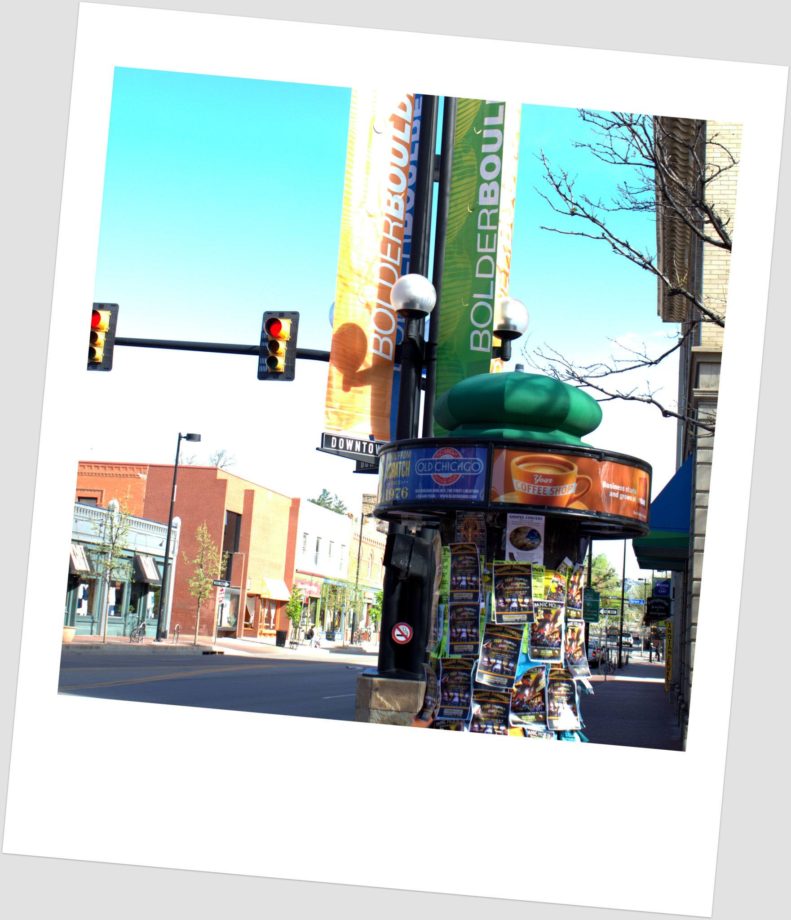 I just returned back from Boulder, Colorado where I spent five amazing days working some of the top running coaches on form and performance. The Newton Running Lab hosted certification training for RRCA, Newton and Lydiard. The content included proper running form with drills, strength exercises, injury prevention, injury management and transition plans. While I was intrigued with the Newton Coaching formula, I was excited that a portion of it mimicked my own. The only part that my personal coaching methodology added was the intricacies of making the running form personal to each person. Newton believes proper running mechanics are the same for everyone, and with the hundreds of hours I spent learning my own body I know this isn’t true, but it is a good place to start.
I just returned back from Boulder, Colorado where I spent five amazing days working some of the top running coaches on form and performance. The Newton Running Lab hosted certification training for RRCA, Newton and Lydiard. The content included proper running form with drills, strength exercises, injury prevention, injury management and transition plans. While I was intrigued with the Newton Coaching formula, I was excited that a portion of it mimicked my own. The only part that my personal coaching methodology added was the intricacies of making the running form personal to each person. Newton believes proper running mechanics are the same for everyone, and with the hundreds of hours I spent learning my own body I know this isn’t true, but it is a good place to start.
The Lydiard Certification training was the best part. Arthur Lydiard was a New Zealand running coach that coached many Olympians to medals including gold in the 1500 meters and beyond. He later mentored other coaches to a point where he is actually considered “The Coach of Coaches of Champions.” Obviously, this resonated with me because Arthur himself was not a competitor, but he coached more champion runners than any other coach to this day. As I really do not compete with anyone other than myself for PRs, this validated my feelings on coaching and my passion for it. As this is a coaching method, not a form method, it also validated a lot of what I already incorporate, but I also enhanced my knowledge greatly.
It was taught by Lorraine Moller who herself was a three time Olympian to include racing in the first 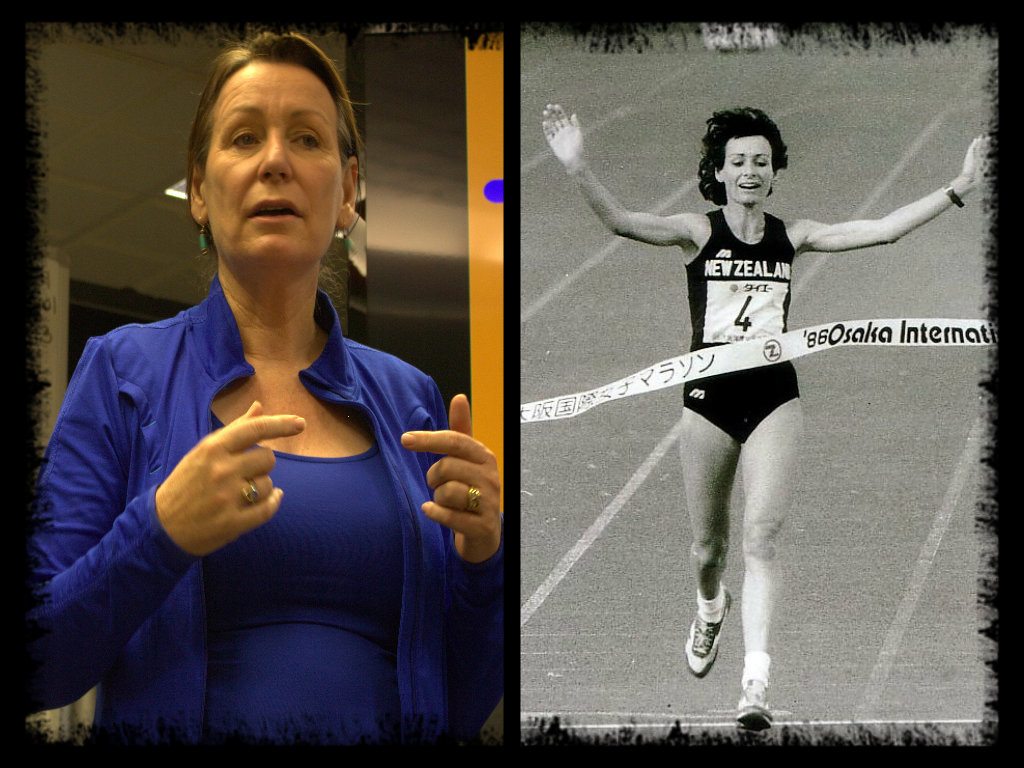 ever Olympic Women’s Marathon in 1984 where she took 5th. She did won bronze in 1992 at the Barcelona games in the Women’s Marathon. Her credits also include winning Grandma’s Marathon three times, the Boston Marathon, the Osaka Ladies Marathon twice, the Hokkaido Marathon twice, and second in the Commonwealth Games. She was coached by John Davies who was mentored by Arthur Lydiard. Lorraine herself was followed by Arthur and would consistently give her pep talks before competition. She is an amazing speaker and completely passionate about running and the Lydiard Coaching method as well as the founder and president of the Lydiard Foundation. I was extremely lucky to have someone as accomplished as she is as an instructor for the class.
ever Olympic Women’s Marathon in 1984 where she took 5th. She did won bronze in 1992 at the Barcelona games in the Women’s Marathon. Her credits also include winning Grandma’s Marathon three times, the Boston Marathon, the Osaka Ladies Marathon twice, the Hokkaido Marathon twice, and second in the Commonwealth Games. She was coached by John Davies who was mentored by Arthur Lydiard. Lorraine herself was followed by Arthur and would consistently give her pep talks before competition. She is an amazing speaker and completely passionate about running and the Lydiard Coaching method as well as the founder and president of the Lydiard Foundation. I was extremely lucky to have someone as accomplished as she is as an instructor for the class.
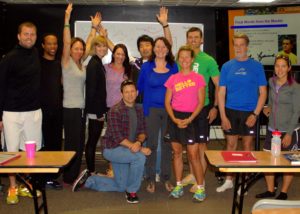
The class was kept fairly small in order to provide us with a lot of individual instruction. We went through analysis of our own form using video which was really interesting. I know that my form isn’t perfect, but my mechanics are good. I found that I actually do not lift my knees as much as I should, and when I applied it later the form became even easier. I learned a lot and I hope to attend the level 3 class later in the year.
Boulder as a city was awesome!!! The scenery was amazing as it was surrounded by mountains and the culture really resonated with me. Boulder’s environment seems to revolve around two things, athletics and the arts. Which are my two passions, so this city really got under my skin. Everywhere you go, everyone is traveling on bicycles and avid cyclists and triathletes are training. Pearl Street is filled with small businesses, to include, coffee shops, restaurants and bars, and none of them are chains. You cannot find a McDonald’s or Wal-Mart anywhere the residents won’t allow it which is great. The quad-like feeling of this outdoor “mall” for lack of a better term, is filled with musicians playing and practicing, photographers, writers, and artists. It gives the feel of a old small town but with the University of Colorado in the midst, it also brings in a younger element that increases the energy of the area. The weather started the day in the high 50s and increased to the mid 80s and then ended in the high 60s. There is almost no humidity, so the air smells fresh and clean. Since most people utilize people-powered transportation it feels as though exhaust fumes do not even exist. I just fell in-love with Boulder and Colorado. I am not quite sure I ever want to live in a place with winter months, but if I did, I definitely would consider Colorado and Boulder.
My plan is to sit and complete the few posts I have started this weekend to bring you the following:
That should keep me busy for a while. Have an amazing week! Live with Passion.
 |
| PB&J before our ride this weekend |
Have you ever heard that saying “Today is first day of the rest of your life”? Today started my Ironman Journey #2 and I was excited last night to get started. No more excuses, no more waiting, today was the day the plan actually started. Of course I was so excited that I couldn’t sleep last night, but I got up anyway and got on my trainer for an hour of high intensity cycling in order to document my Lactate Threshold Heart Rate and Power Zone.
Today, I had to take two Lactate Threshold tests. The LT test determines at what heart rate and power wattage that you blood delivers oxygen to your muscles most efficiently. The scientific definition is the maximum steady state effort that can be maintained without lactate continually increasing. Lactate builds up not allowing oxygen to be utilized. Stay within the LT and the body will be able to keep working efficiently which turns into long amounts of time at that heart rate.
The greatest thing about knowing your Lactate Threshold is that you can train to make it even more efficient. A higher threshold means the body can keep going at higher intensity which turns into speed in the case of triathlon. The caveat is that in order to increase the LT, it has to be done slowly. More workouts above the LT will increase it, but the more the body and muscles are working above it, the shorter the duration until the muscles learn to work with less oxygen making them work a lot more efficiently. This is why the trends have been hit the gym hard, and the endurance will come.
I have a buddy Blayne, whom decided to make the move to CrossFit which is the epitome of high intensity training. I have done a couple of these workouts in the off-season and the actual work in class may only be 20 minutes, but the participants are wrecked afterwards. Let me get back to Blayne. He started taking part in CrossFit religiously, and trained very little for the Rev3 70.3 and completed it with no problem and did really well. The story doesn’t stop there. He entered a 50 mile road race a few weeks later without running more than 9 miles and he completed it and I saw him two days later as he was entering the coffee shop from another CrossFit class and he looked fine. (Maybe I should put the disclaimer that says “results not typical”?) Did I mention the guy is in his 40s?
More and more I have read about triathletes either taking up CrossFit, High Intensity Training(HIT), or supplementing their training with either. It makes sense. A couple of times a week, a short circuit sets of heavy weight(with good form) and the body works higher than it’s LT training the muscles to work with less oxygen. If the body continues to train this way, it makes sense the muscles adapt to utilizing a lower amount of oxygen. When the intensity is lowered, the heart rate reduces allowing more oxygenated blood to the muscles which actually increases the aerobic capacity or VO2. Increased VO2 allows the body to work harder at a longer rate.
Whew! Enough science. My first week looks like this:
There is a trend I jumped on early in January, right after I finished the Goofy Challenge. The Paleo Lifestyle. Most people would call it a diet, and if it was temporary than I would say they were right. At first I was a little spooked by it, but my friend and coach Amy Bennett Eck, dared me to try the lifestyle for 30 days and see what results I obtained and how I felt.
 |
| Before Paleo |
The first week was tough. I was lethargic, my workouts suffered, and I felt like I had lost a lot of strength and endurance. (Of course that might have also been from the Half Marathon and Marathon I ran the weekend before I started.) Something happened about the middle of the second week. I woke up on Wednesday and I felt better. Interesting thing was, it was immediate. I went to bed Tuesday night after strictly following Paleo for a week plus two days and I woke up on Wednesday, feeling like myself again. I’ll talk about the hi-level science in a minute, but let me just tell you I thought I could take on the world. The following Saturday I ran ten miles faster than I ever had. It was just amazing the energy I had. I don’t have that energy all the time, but I did for the next couple of weeks at least. Ever since then I have keeping a pretty strict Paleo Lifestyle at about 85-90%. The other 15% I attribute to pizza, beer, the occasional ice cream and a few items in my race nutrition.
 |
| On Paleo |
So what is Paleo? The word Paleo comes from the Paleolithic Era or the caveman era. It is basically eating as the caveman did, before processing, before grains, before even beans and legumes. It basically, consists of meats, vegetables, fruits, and nuts. There are some items that are what I would call, “on the line”, specifically, milk and butter only if they came from a grass fed cow. There are no grains, no legumes, and no other dairy. I really thought it was going to be tough and the first week was, but after I toughed out the first week, I really didn’t even miss the bread, pasta, corn, cheese, yogurt or rice. Sounds like a lot doesn’t it? Well let me give you my results; I lost 12 pounds and 4% body fat in that first month. Crazy huh? Because of the Goofy Challenge, my workouts were even cut back that month. Since then I have lost another 5 pounds, 3% more body fat, my race times are faster, I can run, swim and bike longer and I have found my love for cooking again.
Let me tell you about the results of my friend Susan Johnson-Velez. Susan is a lawyer and single mom that was a little overweight, and had a severe case of asthma. She started two months prior to me with just removing dairy, and then started Paleo strictly in December and January like me. Now, she is down 35 pounds and the three medications she took for her asthma has been reduced down to a seasonal herb. Isn’t that crazy? I watched this beautiful woman go from baggy dresses and jeans to mini-skirts and dresses and skinny jeans, tight tops and boots. She came with us as our sherpa for the Chicago Marathon last October and when I saw her again at Jet City Coffee in January, my jaw hit the floor. The difference was amazing, and she has only gotten more fit, thinner and hotter since then.
My instruction book for this lifestyle started with The Paleo Diet for Athletes first printing, but since then Joe Friel and Loren Cordain, Phd have updated it. For the edition I was using, Joel Friel, the father of triathlon training, was instructing the Paleo diet for everything except for pre and post workout meals, and race nutrition. I have not completed my read of the second addition, but from what I can tell, Joel is not adding suggestions for those meals to be Paleo as well.
Why Paleo? The theory is, that grains have two major disadvantages; One, they breakdown into sugar, which if you do not use the carbohydrates right away they end up creating imbalances which increases your insulin levels causing the metabolism to slow down and store fat. Second, a lot of grains contain gluten which is basically poison. If the grain, for example oatmeal, does not naturally contain gluten, then there is more than a possibility that it was packaged a facility that also packages grains that do have gluten causing transference. Interesting enough there is another risk of transference of gluten; through meat. If a cow is grain fed, then the meat may have a high level of gluten along with the milk produced. I have actually started buying meat from a farm in Texas that has only grass fed meat. Slanker’s Farms also has chickens, buffalo, and some fish as well. All of it natural without antibiotics, pesticides or hormones.
The benefits of Paleo start by eliminating all the excess sugar your body doesn’t need or use, and then instead of using sugar for energy it uses fat. Since fat is a lot more dense than sugar, the energy production lasts a lot longer, which means you last a lot longer. Can you imagine working out and being able to go a couple of extra miles, just because you want to? Can you imagine a new outlook on life, not to mention cooking? I found a lot deeper interest in cooking since I started Paleo. Also, depending on your body and where you are at the moment, for every pound of excess you rid your body of, it could translate into a 10-12 second per mile decrease in your running time.
There are a lot of resources out there on Paleo. I personally am only fond of books and articles written by Loren Cordain, Phd and Rob Wolf. There are plenty of great resources for recopies on the internet. Do you think you have to give up brownies? Here is my favorite recipe for Paleo Brownies;

Preheat oven to 325 degrees F
They are awesome, trust me.
Check out the books and articles online and see what you think. I suggest just thirty days, knowing that the first week to two weeks you will probably not feel great, but the energy will hit like electricity once your body converts from burning sugar to burning fat.
I hope you are able to extract some good information and that it may at least increase your interest in this healthy lifestyle.